For the Historical Sew Fortnightly Black & White challenge I decided to make a white item, and a black item (and maybe a black and white item if I get very ambitious this evening!)
My white item? A very sweet, very white, 1860s chemise from the (slightly infamous) Simplicity 9769 Martha McCain ‘The Fashion Historian’ chemise/corset/drawers pattern.
Under normal circumstances, I wouldn’t have bought this pattern, because I usually use period patterns, or make something based off an original item I’ve studied or own (I know it sounds snobbish, but I’d rather know that anything weird, hard to work through or mistake-y is my own fault!). But…I’m teaching sewing so I’m trying to use a lot more commercial patterns, so that I can advise students on them.
Oh, and also, the pattern was basically free. At one of the first Fabric-a-Bracs I went to someone was selling a bag with all the bits for a corset: busk, aiglets, grommets, lacing, and this pattern, for (if I remember correctly) $15! Which is less than a busk costs. So I snapped it up, and have added all the bits to my corset making stash (and probably used them since).
As long as I had the pattern, I thought I’d best give it a try!
I was, to say the least, very pleasantly surprised by the pattern. I cut the size 10, rather than the 14/16 I am based on the measurements (let’s just say that when it comes to Simplicity sizing, I wasn’t born yesterday!), and it made up beautifully. It really is a period-accurate pattern, and while I prefer more description of why things are done, and why they are period accurate in my patterns (a la Wearing History), if you already know how 1860s undergarments work, or don’t care about the research behind a garment, the pattern is just fine as it is.
The pattern was actually very easy to make and put together, though I imagine it would really throw you if this was your first attempt at gussets and geometric patterning. Every piece in the pattern is a rectangle or triangle, and fitting them together is a fun puzzle . Each step is well described (except for step 15, where the drawing shows you putting in the sleeve reinforcement panel backwards), but it does help to have a mental picture of how it’s all going to fit together in the end.
This was a pattern where pattern markings were very important. In fact, you can still see my yellow X markings all over the chemise, as I haven’t had a chance to launder them out yet!
For trim, I used some vandyke (a bit of a theme in my lace choices recently) broderie anglaise that I also picked up at Fabric-a-Brac, and vintage shell buttons that have been in my stash forever.
I made life difficult for myself by sewing the lace down right to the edges – lots of sinking and turning as I navigated those points.
I did all the handsewing with a silk thread, which took most of my time as the cotton is very tightly woven, and hard to handsew through, especially as chilblains begin to claim my hands for another winter.
The Challenge: #9 — Black & White
Fabric: 2.2m of white cotton lawn (from the $5 bin at Fabric Warehouse).
Pattern: Simplicity 9769 Martha McCain ‘The Fashion Historian’ chemise/corset/drawers pattern
Year: 1857-68
Notions: 1.5m white cotton broderie anglaise trim (also a Fabric-a-Brac find), 2 vintage shell buttons, silk and cotton thread.
How historically accurate is it? Because I was just trialling the pattern, I wasn’t too worried about being period perfect. The chemise is primarily machine sewn (pushing it for the early 1860s), though I did do the finishing by hand. The fabric is a tiny bit thin and crisp compared to most period examples, but not beyond the boundaries of normal mid-19th century undergarment fabrics. My lace is a bit modern, but the buttons are perfect. So….70%?
Hours to complete: 4. Really easy except for sewing the lace rows so close to the sleeve gather.
First worn: Just for photos, though it will appear in a lecture at Handmade at the end of the month.
Total cost: $5.00 for the fabric, and another $3 in lace and notions.
I wanted to do a photoshoot with this chemise and my blue corset and red hoops, and the paisley petticoat, but as always, time was short, so I settled for a quick snap of me in the chemise.

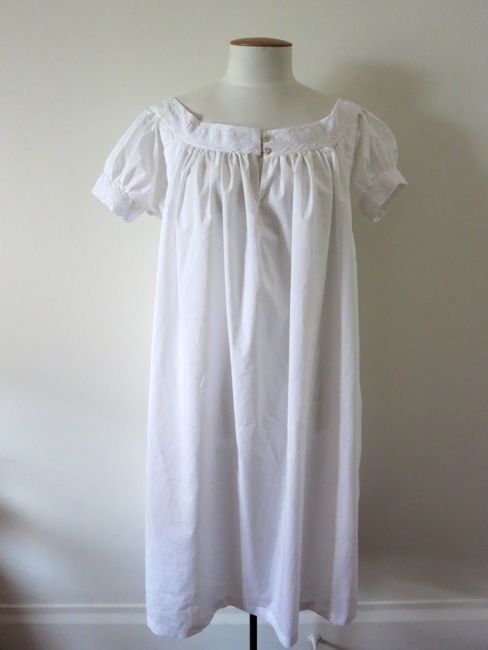

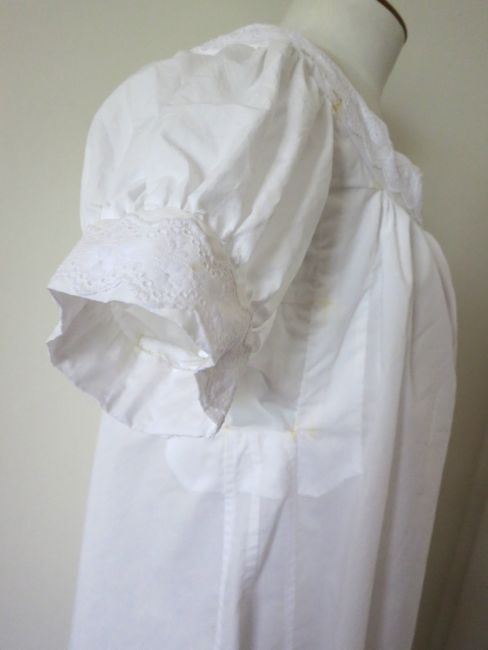

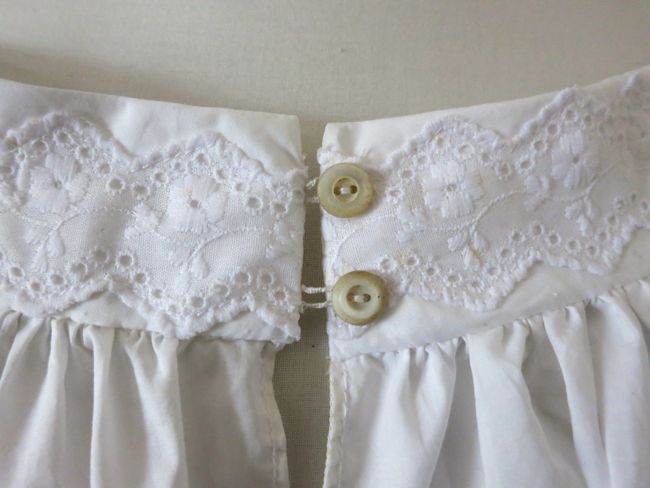
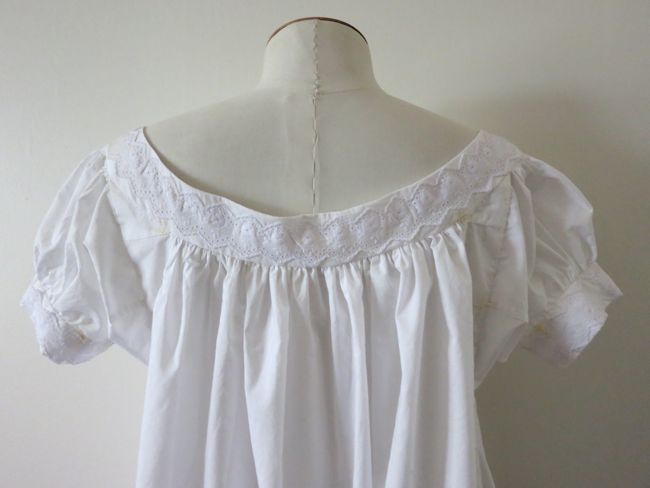
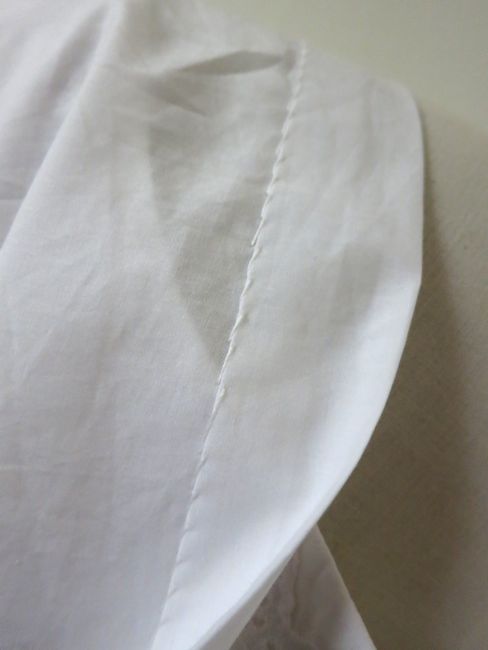
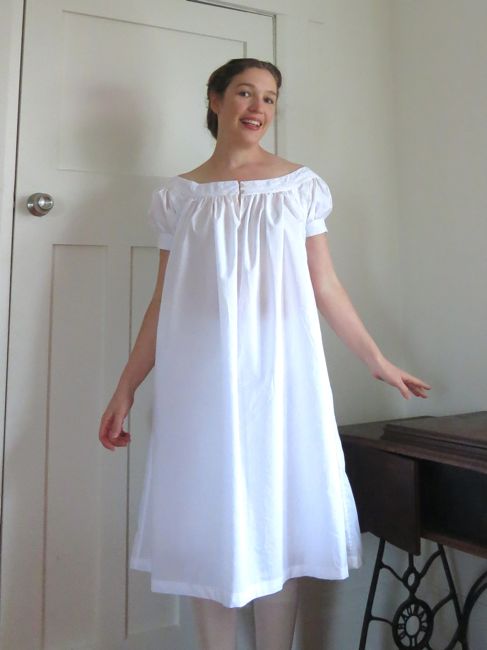
very cool dress , lace could have been sewed right in the middle of yoke. I would say 8/10.
I made that up when I was just learning to sew, and it turned out generally all right, though I’m sure if I tried it now with all my accumulated knowledge it would be much easier! So perhaps I would say that it’s not the easiest thing for beginners, but possible if one is tenacious and like a challenge. I did a similar lace trim on mine, too! Now though, it’s been cut up so I can reuse the fabric for other things, since it wasn’t quite up to snuff for wearing purposes in my fussy, things must be generally perfect wardrobe.
Best,
Quinn
Lovely!
Is that a Standard treadle in the background?!
I have one and I love it to bits!
I’ve made that pattern and it is lovely (if made in the right size). I plan on using mine for a summer nightgown, at least until I get some 1860’s clothing sewn.
This turned out beautifully!
I hope you will have more time one day to photo it with the hoops, petticoat, and corset, I would love to see them all working together!
It IS very sweet! And good about the pattern. 🙂 May I ask why it is infamous? Simplicity sizing?
It is really cute, and it looks like an interesting pattern. I’d like to see it with a corset and hoops too.
I partner with another historic interpreter. We have used the chemise pattern – it is indeed very period accurate! It works well under a corset and the off-the-shoulder style of gown of that period.
That looks gorgeous on you!!! I’m wondering about the underarm gusset. I’ve never seen a period gusset that wasn’t a square. Yours ends cut off on the body. Is that unusual or is it just that I haven’t seen it?
I think that it’s just that you haven’t seen it. Most of the patterns out there for period undergarments go for the simplest, easiest, most basic garment. The 1860s are hitting the era of the sewing machine, so pattern shaping is getting more complicated, and the dissemination of fashion through magazines means that there is both more variation and more uniformity globally. I know Martha McCann is very well respected as a fashion historian, and this chemise is based off extent examples, but examples that are edging towards the use of lots of curves, rather than basic squares.